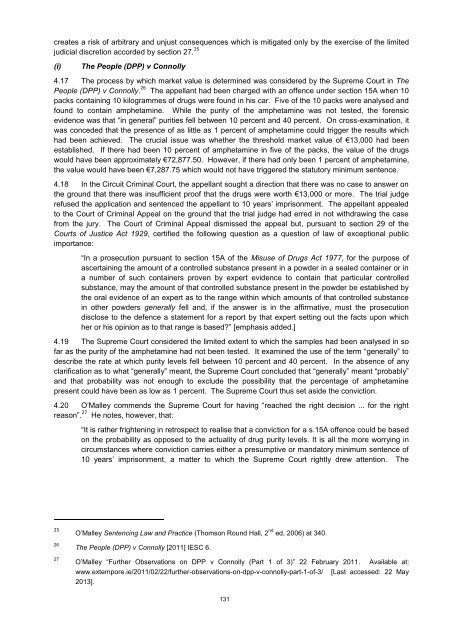Report on Mandatory Sentences - Law Reform Commission
Report on Mandatory Sentences - Law Reform Commission
Report on Mandatory Sentences - Law Reform Commission
Create successful ePaper yourself
Turn your PDF publications into a flip-book with our unique Google optimized e-Paper software.
creates a risk of arbitrary and unjust c<strong>on</strong>sequences which is mitigated <strong>on</strong>ly by the exercise of the limited<br />
judicial discreti<strong>on</strong> accorded by secti<strong>on</strong> 27. 25<br />
(i)<br />
The People (DPP) v C<strong>on</strong>nolly<br />
4.17 The process by which market value is determined was c<strong>on</strong>sidered by the Supreme Court in The<br />
People (DPP) v C<strong>on</strong>nolly. 26 The appellant had been charged with an offence under secti<strong>on</strong> 15A when 10<br />
packs c<strong>on</strong>taining 10 kilogrammes of drugs were found in his car. Five of the 10 packs were analysed and<br />
found to c<strong>on</strong>tain amphetamine. While the purity of the amphetamine was not tested, the forensic<br />
evidence was that “in general” purities fell between 10 percent and 40 percent. On cross-examinati<strong>on</strong>, it<br />
was c<strong>on</strong>ceded that the presence of as little as 1 percent of amphetamine could trigger the results which<br />
had been achieved. The crucial issue was whether the threshold market value of €13,000 had been<br />
established. If there had been 10 percent of amphetamine in five of the packs, the value of the drugs<br />
would have been approximately €72,877.50. However, if there had <strong>on</strong>ly been 1 percent of amphetamine,<br />
the value would have been €7,287.75 which would not have triggered the statutory minimum sentence.<br />
4.18 In the Circuit Criminal Court, the appellant sought a directi<strong>on</strong> that there was no case to answer <strong>on</strong><br />
the ground that there was insufficient proof that the drugs were worth €13,000 or more. The trial judge<br />
refused the applicati<strong>on</strong> and sentenced the appellant to 10 years’ impris<strong>on</strong>ment. The appellant appealed<br />
to the Court of Criminal Appeal <strong>on</strong> the ground that the trial judge had erred in not withdrawing the case<br />
from the jury. The Court of Criminal Appeal dismissed the appeal but, pursuant to secti<strong>on</strong> 29 of the<br />
Courts of Justice Act 1929, certified the following questi<strong>on</strong> as a questi<strong>on</strong> of law of excepti<strong>on</strong>al public<br />
importance:<br />
“In a prosecuti<strong>on</strong> pursuant to secti<strong>on</strong> 15A of the Misuse of Drugs Act 1977, for the purpose of<br />
ascertaining the amount of a c<strong>on</strong>trolled substance present in a powder in a sealed c<strong>on</strong>tainer or in<br />
a number of such c<strong>on</strong>tainers proven by expert evidence to c<strong>on</strong>tain that particular c<strong>on</strong>trolled<br />
substance, may the amount of that c<strong>on</strong>trolled substance present in the powder be established by<br />
the oral evidence of an expert as to the range within which amounts of that c<strong>on</strong>trolled substance<br />
in other powders generally fell and, if the answer is in the affirmative, must the prosecuti<strong>on</strong><br />
disclose to the defence a statement for a report by that expert setting out the facts up<strong>on</strong> which<br />
her or his opini<strong>on</strong> as to that range is based” [emphasis added.]<br />
4.19 The Supreme Court c<strong>on</strong>sidered the limited extent to which the samples had been analysed in so<br />
far as the purity of the amphetamine had not been tested. It examined the use of the term “generally” to<br />
describe the rate at which purity levels fell between 10 percent and 40 percent. In the absence of any<br />
clarificati<strong>on</strong> as to what “generally” meant, the Supreme Court c<strong>on</strong>cluded that “generally” meant “probably”<br />
and that probability was not enough to exclude the possibility that the percentage of amphetamine<br />
present could have been as low as 1 percent. The Supreme Court thus set aside the c<strong>on</strong>victi<strong>on</strong>.<br />
4.20 O’Malley commends the Supreme Court for having “reached the right decisi<strong>on</strong> ... for the right<br />
reas<strong>on</strong>”. 27 He notes, however, that:<br />
“It is rather frightening in retrospect to realise that a c<strong>on</strong>victi<strong>on</strong> for a s.15A offence could be based<br />
<strong>on</strong> the probability as opposed to the actuality of drug purity levels. It is all the more worrying in<br />
circumstances where c<strong>on</strong>victi<strong>on</strong> carries either a presumptive or mandatory minimum sentence of<br />
10 years’ impris<strong>on</strong>ment, a matter to which the Supreme Court rightly drew attenti<strong>on</strong>. The<br />
25<br />
26<br />
27<br />
O’Malley Sentencing <strong>Law</strong> and Practice (Thoms<strong>on</strong> Round Hall, 2 nd ed, 2006) at 340.<br />
The People (DPP) v C<strong>on</strong>nolly [2011] IESC 6.<br />
O’Malley “Further Observati<strong>on</strong>s <strong>on</strong> DPP v C<strong>on</strong>nolly (Part 1 of 3)” 22 February 2011. Available at:<br />
www.extempore.ie/2011/02/22/further-observati<strong>on</strong>s-<strong>on</strong>-dpp-v-c<strong>on</strong>nolly-part-1-of-3/ [Last accessed: 22 May<br />
2013].<br />
131
















